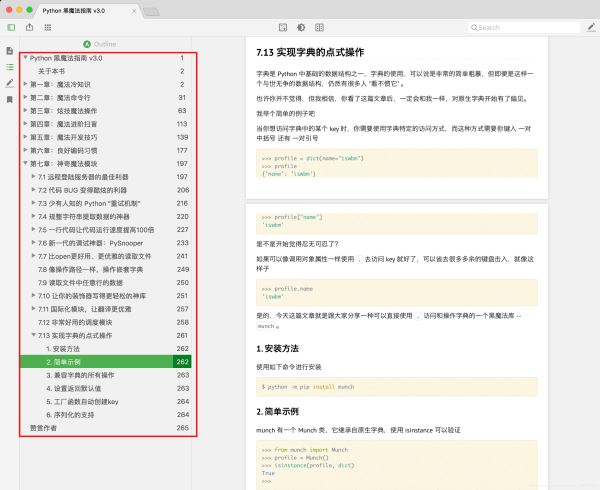您好,登錄后才能下訂單哦!
您好,登錄后才能下訂單哦!
本篇內容主要講解“Python黑魔法庫安裝及操作字典的方法教程”,感興趣的朋友不妨來看看。本文介紹的方法操作簡單快捷,實用性強。下面就讓小編來帶大家學習“Python黑魔法庫安裝及操作字典的方法教程”吧!
當你想訪問字典中的某個 key 時,你需要使用字典特定的訪問方式,而這種方式需要你鍵入 一對中括號 還有 一對引號
>>> profile = dict(name="iswbm")
>>> profile
{'name': 'iswbm'}
>>> profile["name"]
'iswbm'是不是開始覺得忍無可忍了?
如果可以像調用對象屬性一樣使用 . 去訪問 key 就好了,可以省去很多多余的鍵盤擊入,就像這樣子
>>> profile.name 'iswbm'
是的,今天這篇文章就是跟大家分享一種可以直接使用 . 訪問和操作字典的一個黑魔法庫 – munch。
使用如下命令進行安裝
$ python -m pip install munch
munch 有一個 Munch 類,它繼承自原生字典,使用 isinstance 可以驗證
>>> from munch import Munch >>> profile = Munch() >>> isinstance(profile, dict) True >>>
并實現了點式賦值與訪問,profile.name 與 profile['name'] 是等價的
>>> profile.name = "iswbm"
>>> profile.age = 18
>>> profile
Munch({'name': 'iswbm', 'age': 18})
>>>
>>> profile.name
'iswbm'
>>> profile["name"]
'iswbm'本身 Munch 繼承自 dict,dict 的操作也同樣適用于 Munch 對象,不妨再來驗證下
首先是:增刪改查
# 新增元素
>>> profile["gender"] = "male"
>>> profile
Munch({'name': 'iswbm', 'age': 18, 'gender': 'male'})
# 修改元素
>>> profile["gender"] = "female"
>>> profile
Munch({'name': 'iswbm', 'age': 18, 'gender': 'female'})
# 刪除元素
>>> profile.pop("gender")
'female'
>>> profile
Munch({'name': 'iswbm', 'age': 18})
>>>
>>> del profile["age"]
>>> profile
Munch({'name': 'iswbm'})再者是:一些常用方法
>>> profile.keys()
dict_keys(['name'])
>>>
>>> profile.values()
dict_values(['iswbm'])
>>>
>>> profile.get('name')
'iswbm'
>>> profile.setdefault('gender', 'male')
'male'
>>> profile
Munch({'name': 'iswbm', 'gender': 'male'})當訪問一個字典中不存在的 key 時,會報 KeyError 的錯誤
>>> profile = {}
>>> profile["name"]
Traceback (most recent call last):
File "<stdin>", line 1, in <module>
KeyError: 'name'對于這種情況,通常我們會使用 get 來規避
>>> profile = {}
>>> profile.get("name", "undefined")
'undefined'當然你在 munch 中仍然可以這么用,不過還有一種更好的方法:使用 DefaultMunch,它會在你訪問不存在的 key 時,給你返回一個設定好的默認值
>>> from munch import DefaultMunch
>>> profile = DefaultMunch("undefined", {"name": "iswbm"})
>>> profile
DefaultMunch('undefined', {'name': 'iswbm'})
>>> profile.age
'undefined'
>>> profile
DefaultMunch('undefined', {'name': 'iswbm'})上面使用 DefaultMunch 僅當你訪問不存在的 key 是返回一個默認值,但這個行為并不會修改原 munch 對象的任何內容。
若你想訪問不存在的 key 時,自動觸發給原 munch 中新增你想要訪問的 key ,并為其設置一個默認值,可以試一下 DefaultFactoryMunch 傳入一個工廠函數。
>>> from munch import DefaultFactoryMunch
>>> profile = DefaultFactoryMunch(list, name='iswbm')
>>> profile
DefaultFactoryMunch(list, {'name': 'iswbm'})
>>>
>>> profile.brothers
[]
>>> profile
DefaultFactoryMunch(list, {'name': 'iswbm', 'brothers': []})Munch 支持序列化為 JSON 或者 YAML 格式的字符串對象
轉換成 JSON
>>> from munch import Munch
>>> munch_obj = Munch(foo=Munch(lol=True), bar=100, msg='hello')
>>>
>>> import json
>>> json.dumps(munch_obj)
'{"foo": {"lol": true}, "bar": 100, "msg": "hello"}'轉換成 YAML
>>> from munch import Munch >>> munch_obj = Munch(foo=Munch(lol=True), bar=100, msg='hello') >>> import yaml >>> yaml.dump(munch_obj) '!munch.Munch\nbar: 100\nfoo: !munch.Munch\n lol: true\nmsg: hello\n' >>> >>> print(yaml.dump(munch_obj)) !munch.Munch bar: 100 foo: !munch.Munch lol: true msg: hello >>>
建議使用 safe_dump 去掉 !munch.Munch
>>> dict_obj = {"1.2": "hello"}
>>> dict_obj["1.2"]
'hello'以上就是關于 munch 的使用全解,munch 的進一步封裝使得數據的訪問及操作更得更加 Pythonic ,替換原生字典在大部分場景下都不會有太大問題。
但同時也不得不承認,munch 在一些場景下無法達到原生字典的效果,比如我想字典里的 key 為 "1.2" 的時候,原生字典能很好的表示它。
>>> dict_obj = {"1.2": "hello"}
>>> dict_obj["1.2"]
'hello'切換到 munch ,你會發現無法在初始化 munch 對象的時候,傳入 1.2 的 key
>>> from munch import Munch >>> dict_obj = Munch(1.2="hello") File "<stdin>", line 1 dict_obj = Munch(1.2="hello") ^ SyntaxError: expression cannot contain assignment, perhaps you meant "=="?
就算你用原生的字典的方式添加了這個 key-value,也根本無法使用 . 的方式取到 1.2 對應的 value。
>>> from munch import Munch
>>> dict_obj = Munch()
>>> dict_obj["1.2"]="hello"
>>> dict_obj
Munch({'1.2': 'hello'})
>>> dict_obj.1.2
File "<stdin>", line 1
dict_obj.1.2
^
SyntaxError: invalid syntax也正是因為這樣,原生字典至今還是不可替代的存在。
以上就今天跟大家分享的內容,這篇文章是《Python黑魔法手冊》 v3.0 版的最后一篇文章,目前 PDF 已經制作完成。

到此,相信大家對“Python黑魔法庫安裝及操作字典的方法教程”有了更深的了解,不妨來實際操作一番吧!這里是億速云網站,更多相關內容可以進入相關頻道進行查詢,關注我們,繼續學習!
免責聲明:本站發布的內容(圖片、視頻和文字)以原創、轉載和分享為主,文章觀點不代表本網站立場,如果涉及侵權請聯系站長郵箱:is@yisu.com進行舉報,并提供相關證據,一經查實,將立刻刪除涉嫌侵權內容。